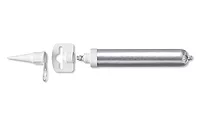Sausage Packaging: A Flexible Alternative
Whether the required amount of adhesive is 40 ml or 40 L, sausage packs are a flexible alternative.
Although the U.S. considers the 300 and 600 ml sausage packages to be industry standards, many other options are now being used worldwide. On the lower end of the spectrum, the 40-ml size typically comes in an 18-mm-diameter sausage. This size is currently being used as a replacement for squeeze tubes for a variety of products such as threadlock adhesives, hand cleaners and product samples.
The 40-L sausage is at the other end of the spectrum. Usually packaged into a 150-mm-diameter sausage, these sausages are often intended as a liner for a reusable pail or container. They can contain materials such as drywall paste or any product that can be pumped.
New and Improved
One of the newest sausage packages is re-closable product. These packages are produced in sizes from 80-250 ml, which is ideal for adhesives and sealants intended for the do-it-yourself market. Automatic and semi-automatic packaging equipment has been developed to apply the re-closable cap to the sausage pack.
The caps are also available with a self-piercing feature, which eliminates the need to cut off the clip before use. Guns are currently available for the 80-ml package, providing a viable replacement option for squeeze tubes that are currently displayed in blister packs. Since the cap has a hanger available, packaging cost is reduced. The 250-ml size, with a re-closable and self-piercing cap, can be dispensed with a typical over-the-counter caulking gun using a reusable sausage sleeve. This eliminates the need for a specialty sausage dispensing gun.
The flooring adhesive industry is also using the sausage pack for its products, typically into a 1.8-2-L package. Guns are available to accept this size of sausage for easy application. Some of the guns have the ability to dispense three sausages at once (side by side), resulting in more time dispensing product and less time changing sausages. The guns are used in a standing position, which is much more ergonomic than bending over to remove the adhesive from a pail. The applicator on the end of the gun dispenses beads of adhesive that are the same size as the product being adhered. This eliminates the need for kneeling onto the floor and using a trowel. Since the sausage is completely compressed, less waste remains than would have usually been left in a pail, resulting in a higher percentage of dispensed product.
Sausages are also used with two-component products. Since the sausages can be customized in diameter and length, it is now possible to make the two-component systems in ratios from 1:1 through 10:1. Guns are available to dispense the same ratios.
Benefits and Advantages
Packaging products in sausages has many advantages. First of all, the packaging itself offers cost savings. Packaging in sausages (vs. conventional cartridges) usually results in savings of 25-50%, depending on the type of film required.
It is also important to consider shelf life. The equipment that uses a flat film that is then formed into a sausage and clipped with product inside has no chance of air ingress during the filling process. Other available films, such as multi-layered film with a trapped aluminum, provide an excellent moisture barrier. Along with an airtight clip closure, this results in extended shelf life.
The space savings benefit should also be taken into account. One roll of 1,000-m film that is formed into sausages takes the place of over 2,000 pre-formed cartridges (about two pallets), resulting in substantial warehouse space savings and incoming shipment costs.
The use of a sausage pack also provides savings in disposal costs. Since an empty sausage container is basically a small, compressed foil disc that is 10% the size of a typical empty cartridge, disposal cost savings can reach 90%. This also results in 90% less waste going to the landfill, which is a key component in environmental sustainability.
With continuing advancements in packaging equipment, films that are becoming available, and different guns and applicators to dispense materials from sausages, there really is no limitation to the use of this type of package.
For more information, contact the author at (847) 949-2800 or b.wines@polyclip.us, or visit www.polyclip.com.
Looking for a reprint of this article?
From high-res PDFs to custom plaques, order your copy today!





